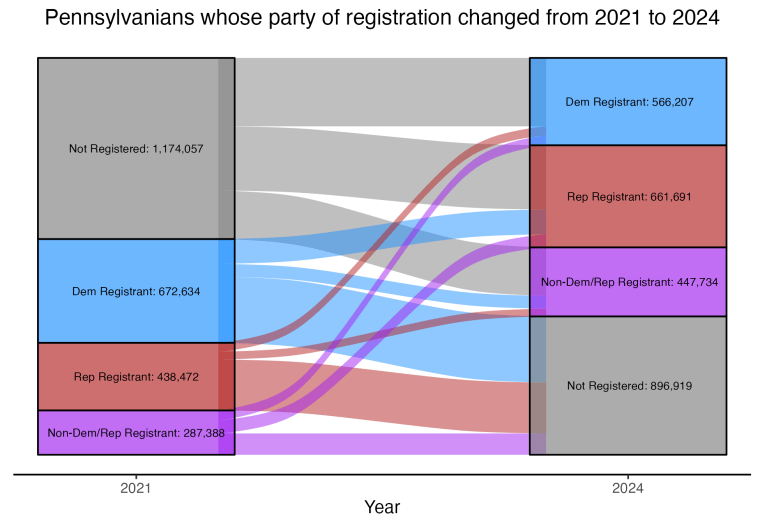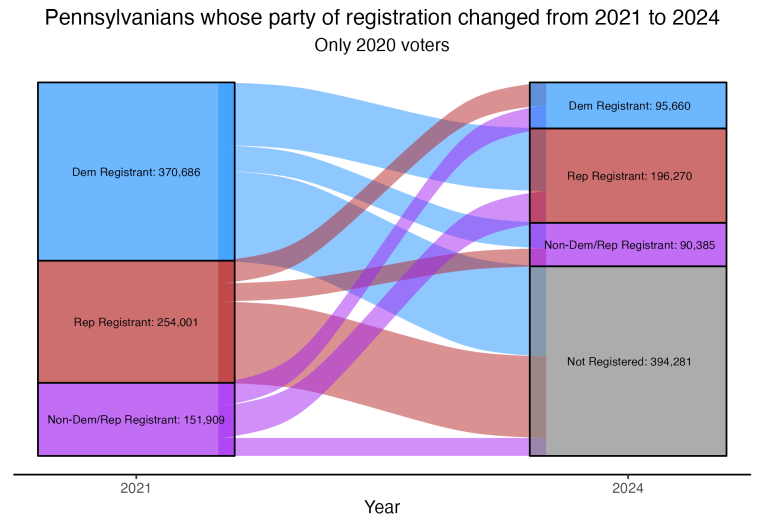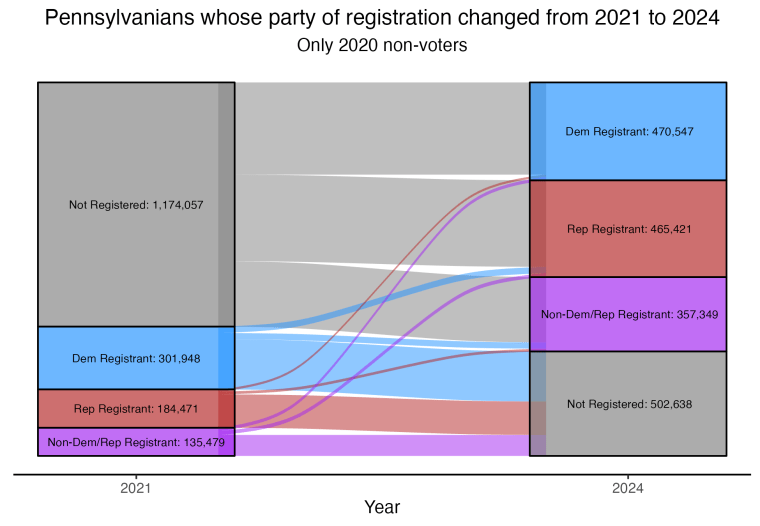Pennsylvania is perhaps the most pivotal swing state up for grabs in this election, just like it was in 2020. But there have been some big changes in the state since last time at the registered voter level.
One reason why Republicans are optimistic about their chances to retake the state is Pennsylvania’s voter registration numbers: While there are still more registered Democrats than registered Republicans, in March 2021, there were 630,000 more registered Democrats than Republicans in Pennsylvania. In October 2024, this discrepancy was cut in half, now standing at around 300,000.
Several factors cause shifts in voter registration numbers. First, some existing registrations get removed from the rolls when those people die, move, or go too long without voting. Existing registrants also sometimes change their party of registration. Finally, new registrants are constantly being added to the rolls.
To better understand which of these factors is causing the Democratic registration edge to narrow in Pennsylvania, the NBC News Decision Desk merged together individual registrations from its voter database in March 2021 and October 2024 to track how registered voters were moving between parties and status.
The chart below illustrates all of the changes in registrants’ parties over this time period. Overall, it shows that there are about 110,000 fewer registered Democrats in 2024 than in 2021, and about 220,000 more registered Republicans.

Already registered voters changing their party has been the most consequential factor narrowing the Democratic registration edge. Over 160,000 people who were registered Democrats in 2021 are now registered Republicans.
Conversely, only 58,000 Republicans shifted their registration to Democratic during the same time period.
Moreover, another 83,000 people who were registered as Democrats in 2021 have switched to being unaffiliated with a major party. A little more than half of that number of previously registered Republicans — 50,000 — did the same.
Then, registration removals also contributed to narrowing the Democratic registration edge. There were about 430,000 Democrats in 2021 who are no longer registered in 2024, as compared to about 330,000 Republicans.
But new voter registrations have not played a role in the narrowing Democratic Party registration edge. In fact, slightly more people who have registered since 2021 are now registered Democrats than registered Republicans.
The electoral impact of the registration changes
How might these changes affect the 2024 election? Looking specifically at voters who cast a ballot in the 2020 election could help answer that question.
Just looking at 2020 voters who have changed their party since then, about 130,000 registrants who were Democrats when they voted in 2020 are now registered Republicans.
Conversely, only 47,000 registrants who were Republicans when they voted in 2020 shifted to being registered Democrats.
More 2020 voters who were independents then have registered as Republicans than as Democrats. Finally, among 2020 voters who have since had their registrations removed, slightly more were Democratic registrants than Republican registrants.

Another big chunk of the narrowing gap between the parties in registration comes from registration removal of people who didn’t vote in 2020. About 240,000 nonvoting registration records of Democrats were removed, as compared to about 160,000 nonvoting registration records of Republicans. Party switching also plays a smaller role — 31,000 former Democrats turned Republican compared to 11,000 former Republicans who turned Democratic among the 2020 nonvoters who have switched since then.

One important caveat to consider: People vote for candidates, not parties, and people do not always vote for the candidates that match their partisan identification. Moreover, registrants can experience shifts in their partisan identification over time, and a change in registration won’t necessarily come at the same point in the process as a shift in vote preference.
One way to gauge the strength of partisan identification is by looking at how stable party registration is for Pennsylvania registered voters who moved counties. This is a key group to focus on because these people must re-register in their new county — and hence restate their party of registration, giving an updated indication of how they view their current party identification.
The chart below shows that an overwhelming majority of registrants select the same party of registration in their new county that they did in their old county. But a small number do change. And consistent with our analysis above, slightly more are selecting a Republican affiliation and slightly fewer are selecting a Democratic affiliation when they re-register.

So what are the potential electoral consequences of these shifts in party registration?
With respect to registration removals, the impact is unlikely to be consequential because most of that Democratic-leaning group that fell off the voter rolls didn’t participate in the 2020 election.
It is less clear what to make of the party-switching, because only some of the factors driving party switching would have electoral consequences. Some registrants may have supported a different party long before officially changing their registration to match their voting behavior. Others, motivated by Pennsylvania’s closed primary system, may have switched parties to be able to vote in a party’s primary.
The most consequential move would be registrants who changed their affiliation in response to recent political conditions, making these changes a signpost pointing to people who may be shifting from supporting one party in 2020 to another party in 2024. Unfortunately, there is no easy way to know what share of these party shifts are occurring for these different reasons.
One thing is clear: Given how evenly split the state is between Democrats and Republicans, the candidate choices of those Pennsylvania voters that do not hold a party identification are likely to loom large in determining which candidate prevails in the state — and maybe in the whole 2024 presidential election.

Leave a Reply